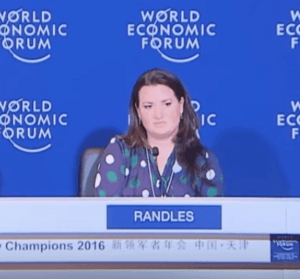Amanda Randles facts for kids
Quick facts for kids
Amanda Randles
|
|
|---|---|

Randles at the WEF Summer Davos in 2016
|
|
| Education | |
| Awards |
|
| Scientific career | |
| Fields | |
| Institutions | Duke University |
| Thesis | Modeling Cardiovascular Hemodynamics Using the Lattice Boltzmann Method on Massively Parallel Supercomputers (2013) |
| Doctoral advisor |
|
Amanda Randles is an American computer scientist. She is a professor at Duke University. She teaches about how computers can help with health and medicine. She also works in computer science, math, and mechanical engineering. She is part of the Duke Cancer Institute. Her work involves using computers to understand diseases and build powerful computer programs.
Contents
Early Life and Education
When Amanda Randles was in high school, she went to the Utica Center for Math, Science, and Technology. There, she learned how to program computers. She also took part in fun competitions like Science Olympiad and FIRST Robotics.
After high school, she studied at Duke University. She earned degrees in physics and computer science in 2005. For three years, she worked as a software developer. She helped create programs for the IBM Blue Gene, which was a very powerful supercomputer.
Later, she went to Harvard University. She earned two more degrees there. She received special awards, like the NSF Graduate Research Fellowship. These awards helped her continue her studies. She also worked at important research places, like the Lawrence Livermore National Laboratory.
Academic Career and Research
In 2015, Amanda Randles joined the Biomedical Engineering Department at Duke University. She became a full professor in 2023. She also teaches in other departments, like math and computer science. She is still a member of the Duke Cancer Institute.
How Computers Help Health
Professor Randles uses computers to study diseases. She wants to understand how illnesses like atherosclerosis (a heart condition) and cancer affect the body. Her team created a special computer program called HARVEY. This program can model how blood flows through a human body. It uses information from CT and MRI scans. HARVEY is named after William Harvey, a doctor who discovered how blood circulates.
This computer program can help doctors. For example, it can show how different treatments for cardiovascular disease affect the circulatory system. It can also model how tiny cancer cells move through the body.
In 2018, Amanda Randles was chosen for a special project. She got to test her computer simulations on the Aurora supercomputer. This is one of the fastest computers in the world. In 2020, she received an NSF CAREER Award. This award helped her continue her important work on the HARVEY program.
Awards and Honors
Amanda Randles has received many awards for her amazing work.
- In 2014, she won the NIH Director's Early Independence Award.
- In 2015, she was named a Young Scientist by the World Economic Forum. This was for her work on using powerful computers to solve physics problems.
- In 2017, she received the Grace Murray Hopper Award. She was also named one of the "Innovators Under 35" by MIT Technology Review. Both awards recognized her work on the HARVEY program.
- In 2023, she received the NIH Pioneer award. This award supports her work using wearable devices with computer models.
- She is also a Fellow of the National Academy of Inventors.
- For her work on helping with ventilators during the Covid-19 pandemic, she received the Alexandra Jane Noble Epiphany Science Inspiration Award.
- In 2023, she won the ACM Prize in Computing. This award recognized her contributions to using computers in health. She created new ways to diagnose and treat many human diseases.
- In January 2024, she was named a Distinguished Member of the ACM.
See also
 In Spanish: Amanda Randles para niños
In Spanish: Amanda Randles para niños

